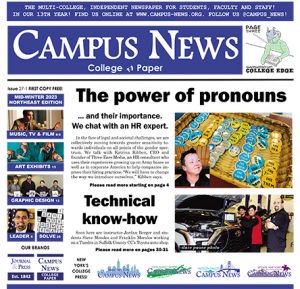By Darren Johnson
Campus News
There’s a guy in my region, the former editor of a small daily paper (that still exists), going around to every library, bookstore and Elks Lodge that will have him speak. His topic is how “print is dead” (and what that means for communities that lose their newspapers), but his purpose for doing all of these speaking engagements is because he’s on a book tour … about dying print.
A PRINTED book tour (he does have an e-edition, too, but it’s probably safe to assume the print edition is the much bigger seller).
Maybe he doesn’t understand irony?
Editors and former editors like him seem to dominate the conversation on the future of news. These are daily newspaper journalists, and they often can be snobby. Because daily papers also cover national and world news (usually via wire services, though), these journalists feel they are doing more important work than those who work in other mediums, such as small town weekly papers. They feel they know more about the state of journalism.
But the reality is, almost every daily paper is owned by a stingy national chain, and their employees are employees of the corporation. In most cases, they are interchangeable McJournalists, trained in college Journalism programs that teach a rather boring style of writing that’s quick to execute (after such intensive training).
The schism in journalism happened midway into the last century. Newspapers did use to value the art of writing – the best paid journalists were popular stunt writers (think Nellie Bly sneaking in the “lunatic” asylum) and gritty columnists who regular people could have a beer with; they understood the poetry of the streets. 
Even then, most of the papers were owned by chains (which still exist today). American papers, to get away from the stunts (that often veered into yellow journalism) decided to go with a more objective style. Journalism no longer was about writing provocative things, but instead was formalized in a way that could be taught.
Writers no longer came from the streets, but colleges – often endowed by the ultra-wealthy newspapers – established Journalism programs where students were taught how to write a basic story: Lead, who/what/ where/when, inverted pyramid, nut graf, quotes, transitions, kicker.
An article was no longer a piece of art, but instead a fill-in-the-blanks craft. (Yes, there are great newspaper writers still, but someone could get by with just craft. The pay’s about the same at these smaller daily papers, whether one is an artist or just a craftsperson – and, frankly, a craftsperson can crank out more stories per pay period, which is what the corporate chains really want.)
This was great for publishers. They no longer were held hostage by celebrity writers who could command top salaries. All of the workers were now interchangeable. Meanwhile, up until a couple of decades ago, the financial end of newspapers was a cash cow. Each classified ad, for example, might command $20, $50, $100 – and there were hundreds of them in every issue – not to mention the other lucrative income sources newspapers had back then. Why offend advertisers with potentially wild writing? But then classifieds and everything else went to independent web sites that didn’t need the news model. Think Craigslist.
(Some people say daily newspapers have gotten more partisan, leaning left; and it’s true that newspapers do attract a certain type of writer today. Perhaps because of the modern, less glamorous, more interchangeable nature of newsroom jobs, the staff may lean more collectivist by nature. No all-stars, a team approach.)
I still get the print edition of the local daily paper mentioned above. A small, older model car rolls up to my mailbox at about 7 a.m. and puts a very thin paper in there. My dogs don’t even bark at this delivery person, though they get heated up over mail and package delivery vehicles. Even the dogs know the newspaper has little bite.
I may skim the local daily paper, or I may not even open it. A past version of myself used to devour any local paper. Now, even a print fanatic like me, is meh about the daily paper.
The problem is, the daily paper, like every other chain daily paper, puts enough of these stories online so that opening the paper is a waste of time. What’s said has already been said.
And because the writing isn’t all that special, even if this paper uses a paywall, I can find a similar story from a paper with a looser paywall just as easily in my social media feed.
As I mentioned, journalists and their writing became interchangeable. We no longer care about the byline. We once used to.
The end result of newspapers losing the art of writing is, there’s nothing special about a typical chain daily print edition. There are no surprises in it. No writerly touches. No quirkiness. No personality. They are McPapers.
If my local daily paper were put together by people who understood the art of writing and the art of creative presentation – maybe they could use some of the techniques cool zines used to use – I’d light up again. A lot of readers would. We’d get this print edition in our mailboxes, and it would be something different. Something fun to unravel.
That’s why paper books still sell. They have originality. You turn the page because you don’t know what’s on the next one.
Putting together a print publication can be a fun thing; not all of the stories need to be exciting. But some of them should at least stir an emotion here and there, or at least take the reader for a little ride.
Sure, print is dead, if the writing in it is dead.
 Darren Johnson keeps busy making this newspaper, and another and teaching some college courses. Contact him at editor@journalandpress.com.
Darren Johnson keeps busy making this newspaper, and another and teaching some college courses. Contact him at editor@journalandpress.com.







Facebook Comments